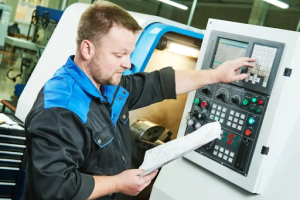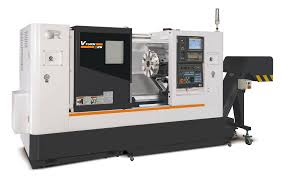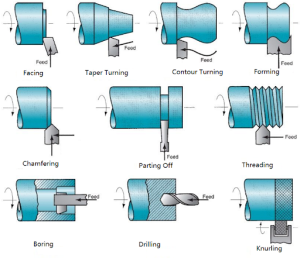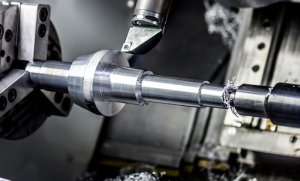What Is CNC Turning? Key Uses, Advantages and Limitations
Modern manufacturing depends on precision, speed, and consistency. Among all machining techniques, CNC turning stands out as one of the most efficient methods for producing round or cylindrical parts with tight tolerances. From aerospace components to automotive shafts and medical fittings, CNC turning delivers exceptional accuracy and surface finish, all powered by digital control and automation.
This guide walks you through everything you need to know about CNC turning, from how it works and its key components to the operations, materials, and advantages that make it a cornerstone of modern engineering.
What is CNC Turning?
CNC turning is a subtractive manufacturing process that involves rotating a workpiece while a cutting tool removes material to form the desired shape. The term CNC stands for Computer Numerical Control, meaning the process is guided by computer-generated commands rather than manual operation. Read more about the general CNC Machining process here.
The machine used is known as a CNC lathe or turning centre, capable of performing a variety of operations from facing and drilling to threading and boring. CNC turning is most commonly used for producing round or tubular parts such as bolts, shafts, spacers, and custom fittings.
By automating tool paths and cutting sequences, manufacturers achieve repeatability, higher production speed, and reduced human error.

How Does CNC Turning Work?
The CNC turning workflow transforms digital designs into finished parts through a series of carefully coordinated steps.
Creating a CAD Model
Every project begins with a 3D CAD model designed using software such as SolidWorks, AutoCAD, or Fusion 360. The model defines dimensions, tolerances, and material specifications.
Converting the Model to G-Code
The CAD file is exported to a CAM (Computer-Aided Manufacturing) program, which converts it into G-code the language CNC machines understand. G-code defines tool paths, spindle speeds, and cutting depths.
Preparing the CNC Turning Machine
The machinist sets up the lathe by installing the appropriate cutting tools, selecting work-holding devices (such as chucks or collets), and loading the raw material bar or billet.
Executing the CNC Turning Process
Once the setup is verified, the program is executed. The spindle rotates the workpiece while the cutting tool moves along pre-defined coordinates, shaping the material layer by layer.
Post-Processing and Finishing
After machining, the part may undergo deburring, polishing, or coating to achieve the desired surface quality and appearance.

Components Manufactured Using CNC Turning
CNC turning is widely used to produce precision-engineered components that require perfect roundness, symmetry, and dimensional accuracy. The process supports everything from simple fittings to complex mechanical assemblies, making it a cornerstone of modern manufacturing.
Typical CNC-turned components include:
- Shafts and Axles: Common in automotive, aerospace, and industrial machinery for power transmission.
- Bushings and Bearings: Provide smooth rotation and reduce friction between moving parts.
- Threaded Fittings and Connectors: Used in plumbing, hydraulics, and pneumatic systems for secure joints.
- Rollers and Pins: Essential for conveyor systems, mechanical linkages, and heavy equipment.
- Spacers and Collars: Maintain precise gaps and alignment in assemblies.
- Couplings and Adapters: Allow the connection of different shafts or system components.
- Valve Components and Housings: Found in oil, gas, and fluid control industries where precision sealing is vital.
- Custom Fasteners and Bolts: Manufactured to unique specifications for specialised applications.
Each of these components benefits from CNC turning’s high accuracy, consistent quality, and smooth surface finish, ensuring reliable performance even under demanding operating conditions.

CNC Turning vs CNC Milling
Although both CNC turning and CNC milling rely on computer numerical control (CNC) for precision and automation, they operate on different principles.
In CNC turning, the workpiece rotates at high speed while the cutting tool remains stationary, gradually removing material to form cylindrical or conical shapes. This process is ideal for producing components like shafts, rods, spacers, bushings, and threaded parts, anything symmetrical around a central axis.
In contrast, CNC milling keeps the workpiece fixed while the cutting tool rotates. Milling machines can move the tool in multiple axes (usually X, Y, and Z), allowing for the creation of complex 3D geometries, flat surfaces, pockets, and contours. It’s perfect for parts that require slots, holes, or intricate shapes that can’t be produced by turning alone.
To put it simply:
Turning = Rotating part, fixed tool → round/cylindrical parts
Milling = Rotating tool, fixed part → flat or irregular shapes
Modern workshops often combine both turning and milling in one setup, known as mill-turn machines or turning centres with live tooling. These advanced machines allow operations like drilling, tapping, or side milling without transferring the part to another machine, saving time, improving accuracy, and increasing throughput.
Learn more about CNC Milling Machine Uses and Types in the separate guide.
CNC Turning Machines and Components
CNC turning machines come in various types and configurations, each tailored to specific production needs, material types, and design complexity. Their adaptability allows manufacturers to produce anything from small precision fittings to large industrial components.
Types of CNC Turning Machines
Horizontal Turning Centres
These are the most commonly used CNC lathes. In this design, the spindle is mounted horizontally, allowing chips to fall away from the work area under gravity. Horizontal machines are ideal for small to medium-sized parts, offering excellent stability, accuracy, and chip removal.
They are well-suited for continuous production and can be equipped with automatic bar feeders, multi-tool turrets, and live tooling attachments for secondary operations.

Vertical Turning Centres (VTCs)
In vertical lathes, the spindle is positioned vertically, and the workpiece is mounted on a horizontal table. This design provides exceptional support for heavy or large-diameter parts, such as turbine discs, brake rotors, and flywheels.
Because gravity assists in centring and holding the part securely, vertical turning centres reduce distortion during machining and are favoured in industries like aerospace and automotive for machining large castings or forgings.

Combination or Multi-Axis Lathes
These advanced systems combine turning and milling functions in a single unit. They often include a Y-axis, C-axis, or B-axis, enabling angular milling, off-centre drilling, and complex contouring.
Multi-axis lathes significantly cut down production time by completing multiple operations in one setup ideal for high-precision parts or custom components with intricate geometries.
Key CNC Turning Operations
The CNC turning process consists of several machining operations, each designed to achieve a particular shape, finish, or function. These operations can be performed individually or programmed sequentially within the same machining cycle to produce complete parts with high precision and consistency.
Facing
Facing is usually the first step in any turning job. It involves moving the cutting tool across the end of a rotating workpiece to create a smooth, flat face. This removes surface imperfections and provides a clean reference surface for all subsequent operations.
Common use: preparing shafts, discs, or flanges where accurate end faces are critical for assembly.
Straight or Parallel Turning
This operation reduces the diameter of the workpiece along its length, producing a perfectly cylindrical shape. The tool moves parallel to the rotation axis, maintaining consistent dimensions and a fine surface finish.
Common use: creating shafts, rods, and spacers for automotive or industrial applications.
Taper Turning
Taper turning produces a conical surface where the diameter gradually decreases or increases along the length. CNC control allows for precise taper angles and consistent geometry.
Common use: manufacturing tool holders, machine spindles, or components requiring a self-locking fit.
Grooving and Parting
Grooving cuts narrow recesses into the workpiece, while parting (also called cut-off) separates the finished component from the remaining bar stock. Grooves often serve as O-ring seats, snap-fit positions, or lubrication channels. Parting operations complete the process by cutting off the finished part cleanly and accurately.
Common use: hydraulic fittings, bushings, and sealing components.
Threading
Threading forms helical grooves on the internal or external surfaces of a part. The CNC system precisely synchronises tool movement with spindle rotation to ensure consistent pitch and thread depth.
Common use: creating bolts, nuts, screws, and threaded pipe connections.
Boring
Boring enlarges pre-drilled holes to achieve exact diameters and smooth internal surfaces. The process requires a rigid boring bar to avoid vibration and ensure tight tolerance.
Common use: producing bearing housings, hydraulic cylinders, and engine components.
Drilling
Drilling in CNC turning is typically performed at the centre of the rotating workpiece. Using stationary or powered drill bits, the machine bores holes with accurate depth and alignment.
Common use: pilot holes, through-holes, and internal passages for mechanical or fluid systems.
Knurling
Knurling is a surface-forming operation that uses a hardened roller to press a textured pattern onto the surface of a rotating workpiece. This improves grip and adds an aesthetic finish.
Common use: tool handles, knobs, and fasteners requiring a non-slip surface.

Understanding CNC Turning Parameters
Several key parameters determine how efficiently and accurately a CNC turning operation runs. Each one influences the final quality, tool life, and production speed.
Spindle Speed (RPM):
Spindle speed defines how fast the workpiece rotates during machining. Higher RPMs suit softer materials like aluminium for smooth finishes, while harder metals require slower speeds to avoid overheating and tool wear. Many modern CNC systems use constant surface speed control to maintain consistent cutting conditions as diameters change.
Feed Rate:
Feed rate controls how quickly the cutting tool advances along the workpiece. A faster feed reduces machining time but can leave tool marks, while a slower feed improves surface finish and accuracy. Machinists typically use a higher feed during roughing and lower feed during finishing for balanced performance.
Depth of Cut:
Depth of cut refers to how deeply the tool engages the material per pass. Deeper cuts are ideal for roughing when removing bulk material, while shallower cuts are used for precision finishing. Finding the right depth helps prevent vibration, excessive load, and poor surface quality.
Coolant Flow:
Coolant plays a vital role in reducing heat, flushing chips, and prolonging tool life. Proper flow prevents chip welding and maintains dimensional accuracy. Depending on the material, machinists may use flood cooling for metals or mist systems for lighter materials to ensure smooth, stable operation.
Toolpath Optimisation:
Toolpath optimization focuses on the programmed movement of the cutting tool. Efficient toolpaths reduce unnecessary retractions, distribute wear evenly, and shorten cycle times. By carefully sequencing cuts and using adaptive tool strategies, machinists achieve consistent, high-quality results across every batch.
For practical design tips that improve machining efficiency, see our guide to designing parts for CNC machining.
Advantages of CNC Turning
CNC turning remains popular because it offers a unique balance of speed, precision, and cost efficiency:
- Exceptional Accuracy: Achieves micron-level tolerances ideal for precision assemblies.
- High Productivity: Automated tool changes and consistent speeds allow continuous operation.
- Lower Labour Cost: Once programmed, a single operator can oversee multiple machines.
- Repeatability: Every part matches the previous one — crucial for mass production.
- Reduced Waste: Controlled toolpaths remove only the necessary material.
- Scalability: Easily shifts between prototype runs and high-volume production.
Discover why CNC machining is ideal for both prototyping and mass production, offering flexibility and precision for every project size.
Applications of CNC Turning
CNC turning is used wherever rotational symmetry and precision are needed:
- Aerospace: Engine shafts, couplings, and hydraulic fittings.
- Automotive: Pistons, axles, wheel hubs, and threaded parts.
- Oil & Gas: Valve stems, pipe connectors, and pressure components.
- Medical: Surgical implants, bone screws, and custom fasteners.
- General Engineering: Rollers, spacers, and custom fixtures.
Because of its versatility, turning is often the foundation of multi-stage machining workflows.

Limitations and Challenges for CNC Turning
While CNC turning is highly efficient, it does have a few natural limitations that manufacturers should keep in mind:
- Limited for Complex Shapes:
Best suited for round or symmetrical parts; not ideal for intricate 3D designs or irregular geometries. - Needs Skilled Programming:
Achieving tight tolerances requires experienced operators to set correct speeds, feeds, and tool paths. - High Initial Cost:
CNC machines and tooling involve a large upfront investment, especially for small workshops. - Surface Finish Issues:
Tool wear, vibration, or improper speeds can lead to rough finishes or dimensional errors. - Technical Maintenance:
Regular calibration and monitoring are needed to keep accuracy and reliability consistent.
Modern CNC systems help reduce these challenges through multi-axis machining, adaptive controls, and real-time feedback, improving precision and productivity across production runs.
Automation and Quality Control in CNC Turning
Automation has taken CNC turning to a new level of efficiency. Features such as bar feeders, robotic part loaders, and in-process sensors reduce manual handling and ensure consistent output across long production runs.
Quality control is equally vital. Most facilities employ:
- In-process probing to check diameters during machining.
- Post-process CMM inspection to verify tolerances.
- Statistical Process Control (SPC) data tracking to monitor consistency over time.
The result is a highly repeatable manufacturing system that aligns with ISO quality requirements.
Precision CNC Turning Expertise by Kirmell Ltd
At Kirmell Ltd, we specialise in precision CNC turning and metal fabrication for a wide range of UK industries. Since 1985, our West Midlands facility has delivered ISO 9002 / EN 29002 certified machining, supporting manufacturers that demand accuracy, reliability, and quality in every component.
Our experienced engineers manage everything from small-batch prototypes to large-scale production, offering high-quality turned parts, steel fittings, pallet feet, and nesting plugs.
Each product reflects our commitment to craftsmanship, advanced CNC technology, and industrial durability that has made Kirmell a trusted manufacturing partner for decades.
Contact us today to discuss your project or request a free quote. We’re here to help you manufacture with precision and confidence.
Conclusion
CNC turning continues to be one of the most productive and precise methods for shaping metal and plastic parts. By combining automated control, advanced tooling, and intelligent programming, it delivers results that meet modern engineering expectations.
Whether you’re developing prototypes or managing full-scale production, working with a trusted partner like Kirmell Ltd ensures that every turned component meets the highest standards of accuracy and durability.
FAQs
Where can I hire CNC turning services in the UK?
What is the difference between CNC turning and CNC milling?
What are CNC-turned parts used for?
What materials can be used in CNC turning?
How accurate is CNC turning?


